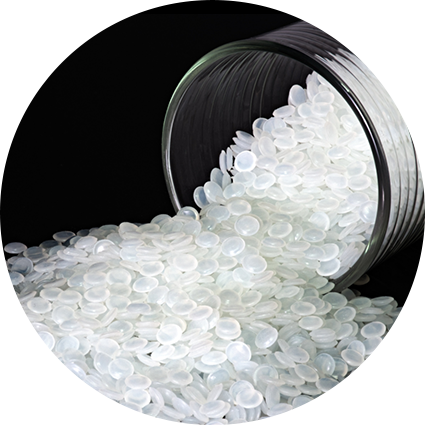What is fully biodegradable film?
Fully biodegradable film is environmentally friendly film products made of fully biodegradable materials such as PLA (polylactic acid) and PBAT (polybutylene adipate/terephthalate). Unlike traditional plastic films that take hundreds of years to degrade, these materials can be decomposed into water and carbon dioxide through microbial action in the natural environment, achieving true "zero pollution".
Core advantages:
1. 100% biodegradability (in compliance with international standards such as EN13432 and ASTM D6400)
This is the most significant feature of biodegradable materials, meaning that they can decompose naturally after use and will not cause lasting pollution to the environment like traditional plastics. Compliance with international standards such as EN13432 and ASTM D6400 indicates that the material has passed rigorous testing to prove its degradability in the natural environment. These standards require that the material degrades within a reasonable time and does not cause long-term harm to soil and water bodies. Products that meet these standards not only reduce environmental pollution, but also drive the world towards a greener and more sustainable future.
2. 3-6 months natural degradation cycle
Traditional plastic materials may take hundreds of years to degrade in the natural environment, which leads to serious environmental problems. The 3-6 month natural degradation cycle significantly shortens this process, and the materials can be decomposed within a few months, reducing garbage accumulation and the burden on the ecosystem. This advantage is particularly suitable for disposable products such as packaging materials, tableware, shopping bags, etc., which can reduce waste while ensuring that their negative impact on the ecological environment is minimized.
3. Maintaining mechanical properties similar to traditional plastics
Although traditional plastics have advantages such as durability and strength in application, they have a greater impact on the environment. The advantage of 100% biodegradable materials is that they can be degraded without sacrificing mechanical properties. This means that these biodegradable materials can maintain similar strength, toughness and durability as traditional plastics in daily use, providing the same user experience. Consumers can enjoy high-performance products similar to traditional plastics while greatly reducing the burden on the environment.
4. Carbon footprint reduced by more than 60%
The carbon emissions generated during the production and use of traditional plastics have a direct impact on climate change and the greenhouse effect. The production process of biodegradable materials reduces the carbon footprint by more than 60% compared to traditional plastics. This advantage not only reduces greenhouse gas emissions during the production process, but also helps to mitigate climate change. Products using biodegradable materials can provide companies and consumers with more environmentally friendly options while reducing environmental impact.
Technical principles and production processes
Analysis of the degradation mechanism of fully biodegradable film: Fully biodegradable film is a material that decomposes in the natural environment through the action of microorganisms, and its degradation process is completely different from the degradation of traditional plastics. The degradation mechanism of fully biodegradable film is mainly based on microbial metabolism. The following is a detailed analysis of this process:
1. Microorganisms attach to the surface of the film and secrete enzymes
In the natural environment, there are a large number of microorganisms (such as bacteria, fungi, etc.), which metabolize with organic matter as energy. For fully biodegradable films, microorganisms first attach to the surface of the film and secrete specific enzymes (such as polymer degrading enzymes, lipases, cellulases, etc.). These enzymes can decompose the polymer structure on the surface of the film and start to degrade it. The role of enzymes is to cut large polymer chains into smaller molecules and break the structure of the film.
2. Breaking of polymer chains into low molecular weight compounds
Under the action of enzymes, the polymer chains of the film (such as polylactic acid, polyhydroxyalkanoates, etc.) are broken into smaller molecular units, which are usually low molecular weight compounds. In this process, the long chain structure of the polymer is cut by the enzyme into multiple low molecular weight compounds, which are easier to be further metabolized. At this time, the physical form of the film gradually disintegrates and enters a stage that is easier to be digested and absorbed by microorganisms.
3. Final conversion into H₂O, CO₂ and biomass
When the polymer chains are degraded into low molecular weight compounds, these small molecular weight compounds will be further absorbed by microorganisms. Microorganisms convert these low molecular weight compounds into water (H₂O), carbon dioxide (CO₂) and biomass through their metabolic processes. Carbon dioxide is released into the air, water returns to the natural environment, and the remaining biomass can be used as an energy source for microorganisms, or enter the soil to continue to provide nutrition for plants and other organisms.
This degradation process can be regarded as a complete ecological cycle without long-term environmental residues. Compared with traditional plastics, the degradation products of biodegradable films are completely natural and will not cause long-term environmental pollution like plastics.
Key factors of degradation
Microbial species: Different types of microorganisms have different abilities to degrade different materials. Usually, microorganisms with enzymes that degrade specific materials are required to effectively degrade.
Environmental conditions: The efficiency of the degradation process is closely related to environmental conditions. For example, temperature, humidity, soil pH, etc. will affect the activity of microorganisms and the speed of the degradation process. In a suitable environment, the degradation process may take from several months to a year.
Film composition: The composition of fully biodegradable films is different, and the degradation speed and method will also vary. For example, polylactic acid (PLA) materials usually have a shorter degradation time under the action of microorganisms, while polyhydroxyalkanoates (PHA) may degrade faster.
Analysis of advanced production processes: In the production of modern packaging materials, the use of advanced process technologies can not only improve the functionality of the product, but also achieve a better balance between environmental protection and cost-effectiveness. The following are several key advanced production processes, which play an important role in material performance, processing efficiency and product adjustability:
1. Multi-layer co-extrusion technology (3-5 layer structure)
Multi-layer co-extrusion technology is a process in which different materials are extruded and synthesized simultaneously in a molten state. Through this technology, multiple different material layers can be superimposed during the production process to form a composite film with different functions. The advantages of this technology are:
Functional diversity: Each layer of material can choose different physical and chemical properties. For example, one layer can have a moisture-proof function, another layer has mechanical strength, and other layers can have barrier properties or heat sealing properties.
Enhanced material performance: Through the combination of different layers, the product can have multiple advantages at the same time, such as anti-permeability, high temperature resistance, anti-static, etc.
Flexibility: The number of layers (3-5 layers) can be adjusted according to actual needs during the production process to meet different packaging requirements.
This technology is widely used in food packaging, medical packaging, industrial packaging and other fields, and can provide higher protection and better use experience.
2. Nano-modification enhancement technology
Nano-modification technology is a method of enhancing the performance of traditional materials by introducing nano-scale materials (such as nanoparticles, nanofibers, etc.). By adding nano-materials to the substrate, the mechanical, thermal, optical and other properties of the material can be significantly improved. Its main advantages include:
Enhanced mechanical properties: Nano-materials can enhance the strength, toughness and wear resistance of the film, making the film more durable.
Improved barrier properties: Nano-technology can significantly improve the barrier properties of packaging materials, preventing the penetration of substances such as moisture, oxygen, and light, thereby extending the shelf life of the items in the package.
Lightweight design: Nano-materials can effectively reduce the weight of the package without compromising its performance, which is crucial to reducing transportation costs and material usage.
Nano-modification enhancement technology is widely used in food, medicine, electronic component packaging and other fields, which can provide higher protection and extend the service life of the product.
3. Low-temperature heat sealing process (90-110℃)
Low-temperature heat sealing process is a technology that performs heat sealing at a relatively low temperature (usually 90-110℃). Heat sealing refers to the process of heating two layers of material and applying pressure to bond them together. The advantages of low-temperature heat sealing technology are mainly reflected in the following aspects:
Energy saving and environmental protection: The low-temperature heat sealing process consumes less energy, meets the requirements of energy saving and environmental protection, and helps to reduce carbon emissions in the production process.
Strong adaptability: It is suitable for heat sealing of a variety of materials, especially those that are sensitive to temperature (such as certain biodegradable materials, films, etc.). This process can avoid high temperature damage to the material and maintain the integrity and beauty of the packaging.
Improve production efficiency: Due to the low heat sealing temperature, the heat sealing time can be shortened, the production efficiency can be improved, and the material degradation problem that may be caused by high temperature can be avoided.
This process is widely used in food packaging, pharmaceutical packaging and other fields, which can ensure the safety of packaging while reducing energy consumption in the production process.
4. Thickness range 15-200μm adjustable
During the production process, through advanced process control, the thickness range of the film can be adjusted between 15-200μm. This adjustability makes the product more flexible and can choose the appropriate thickness according to different application requirements. Specifically:
Film thickness adjustment: For some applications that require high air permeability or flexibility, thinner films (such as 15-50μm) are more suitable. For applications that require strong mechanical strength or protective performance, thicker films (such as 100-200μm) can be selected.
Optimize material utilization: Adjusting the thickness of the film according to product requirements can not only save materials, but also achieve higher production efficiency.
Adapt to different packaging needs: By adjusting the thickness of the film, the packaging requirements of different products can be met, and it is suitable for a variety of industries, such as food, electronics, medical and other fields.
Analysis of six major application areas
| Application Area |
Specific Applications |
| Industrial Packaging |
Anti-static packaging for electronic components, anti-rust packaging for mechanical parts, waterproof sealing for building materials, replacement for traditional PE stretch film, PVC shrink film |
| Food Packaging Innovation |
Fresh fruit and vegetable preservation film, frozen food packaging, bakery product packaging (FDA, EU10/2011 food contact certified) |
| Agricultural Film Revolution |
Reduction of "white pollution", composting and direct soil application, customizable light transmission/ventilation rates |
| Medical Protective Products |
Biodegradable surgical drapes, eco-friendly outer layers for masks, pharmaceutical blister packaging |
| Consumer Goods |
Eco-friendly shopping bags, disposable product packaging, courier envelope liners |
| Special Uses |
Water-soluble pesticide packaging, submarine cable protective film, seed cultivation substrates |










